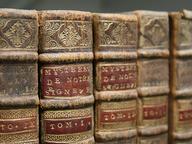The first decades (1830s to 1860s) of Queen Victoria’s reign produced a vigorous and varied body of literature that attempted to come to terms with the current transformations of English society, but writers in the latter decades (1870s to 1900) withdrew into AESTHETICISM, a preoccupation with sensation as an end in itself.
Confronted by the shift from an agricultural to an industrial urban society and troubled by the erosion of traditional religious beliefs, the early  Victorian writers held to a moral aesthetic, a belief that literature should provide both an understanding of and fresh values for a new society. Novelists of the period explored the difficulty of forming a personal identity in a world in which traditional social structures appeared to be dissolving. With compassionate realism, George ELIOT, in such works as ADAM BEDE, described the slow dissolution of a rural community. The many powerful novels of Charles DICKENS, William Makepeace THACKERAY, and Anthony TROLLOPE focused on the isolation of the individual within the city. Charlotte BRONTE in JANE EYRE dramatized the particular problems of creating a female identity. Among the writers of early Victorian nonfiction, Thomas CARLYLE in Past and Present (1843) argued for the re-creation in industrial England of the lost sense of community between social classes. In contrast, John Stuart MILL in ON LIBERTY spoke for the fullest development of the individual through freedom from social restraint. The foremost art critic of the time, John RUSKIN, articulated the assumptions of many contemporary critics by showing in The Stones of Venice (1851-53) the interdependence of great art and a society’s moral health.
Victorian writers held to a moral aesthetic, a belief that literature should provide both an understanding of and fresh values for a new society. Novelists of the period explored the difficulty of forming a personal identity in a world in which traditional social structures appeared to be dissolving. With compassionate realism, George ELIOT, in such works as ADAM BEDE, described the slow dissolution of a rural community. The many powerful novels of Charles DICKENS, William Makepeace THACKERAY, and Anthony TROLLOPE focused on the isolation of the individual within the city. Charlotte BRONTE in JANE EYRE dramatized the particular problems of creating a female identity. Among the writers of early Victorian nonfiction, Thomas CARLYLE in Past and Present (1843) argued for the re-creation in industrial England of the lost sense of community between social classes. In contrast, John Stuart MILL in ON LIBERTY spoke for the fullest development of the individual through freedom from social restraint. The foremost art critic of the time, John RUSKIN, articulated the assumptions of many contemporary critics by showing in The Stones of Venice (1851-53) the interdependence of great art and a society’s moral health.
The major early Victorian poets, too, took the role of secular prophets, often expressing a longing for the free play of imaginative life. For Alfred, Lord TENNYSON, the longing found ambivalent expression in his early lyrics; his major work, In Memoriam (1850), translated personal grief into an affirmation of religious faith. Matthew ARNOLD, particularly in his poem Empedocles on Etna (1852), revealed how the spirit of his own age weakened emotional vitality. Although concerned with presenting his personal form of religious faith, Robert BROWNING used his dramatic monologues primarily to show the uniqueness of the individual personality.
By the 1870s, opposing what they now perceived as a repressive public morality, writers increasingly rejected any obligation to produce didactic art. In the influential Conclusion to Studies in the History of the Renaissance (1873), Walter PATER argued that moments of intense sensation are the highest good and that the function of art must be to create such moments. In poetry, Dante Gabriel ROSSETTI and Algernon Charles SWINBURNE expressed their private erotic concerns in terms shocking to the general public. Such preoccupation with sensation led to the literary decadence of the 1890s, epitomized by Oscar WILDE’s play Salome (1893), with illustrations by Aubrey BEARDSLEY. Along with a revitalization of prose fantasy (see William MORRIS, Robert Louis STEVENSON), the later Victorian period also saw a more searching realism, notably in such novels of Thomas HARDY’s as JUDE THE OBSCURE and TESS OF THE D’URBERVILLES.
